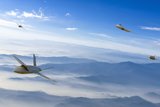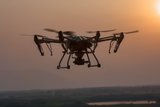New IMU - rugged, precise inertial sensing for the smallest platforms (sponsored)
The new DMU41 silicon MEMS IMU
This article is brought to you by Silicon Sensing Systems Ltd.
DMU41 - the highest performing silicon MEMS IMU available today - is packaged in a unit that is approaching half the size, weight and power consumption of its predecessor. This new IMU will bring precision inertial sensing to even smaller and more restricted platforms, operating in the severest environments.
Silicon Sensing Systems has developed a new 9 degrees of freedom (DoF) inertial measurement unit (IMU) which extends the class-leading performance of its predecessor, the DMU30, whist delivering a dramatic reduction in volume, weight and power consumption.
Steve Capers, General Manager, Silicon Sensing Systems Ltd, explains: “We have developed the DMU41 in close consultation with customers across many market sectors, including defence and autonomous vehicles. Many expressed a need for a highly compact, ‘tactical grade’ IMU that is not ITAR (International Traffic in Arms Regulations) controlled.”
At only 50x50x50mm, and weighing just 200g, the new DMU41 has a 54% lower volume and weighs 42% less than the DMU30. In addition, its power consumption is half the typical usage of DMU30.
This new, ultra-compact micro electro-mechanical systems (MEMS) IMU will also extend the performance of the DMU30, to deliver the inertial sensing performance equivalent to far heavier, larger and more costly, fibre-optic gyro-based IMUs. This combination of small size and power consumption with impressive performance, all packaged in a rugged MEMS unit, will bring precision motion sensing to a new range of applications including the smallest and most restricted surface and sub-surface platforms.
The DMU41 – the highest performing silicon MEMS IMU available today
Steve Capers continues: “Our new IMU will find a home operating in the most demanding situations - such as the military and unmanned vehicles markets, where consistent, ultra-precise motion sensing is critical but available space and power are typically very limited. In fact, the potential applications are so many and varied that we look forward to being surprised by interest from unexpected quarters!”
DMU41 is an all-silicon MEMS IMU that delivers unparalleled inertial performance, combining excellent angle random walk and bias stability with exceptional low noise characteristics. The 9 DoF unit combines best-in-class sensors, including three inductive and three piezoelectric resonating ring gyroscopes, and six capacitive accelerometers - all designed and manufactured at Silicon Sensing’s own foundry. It also includes 3 magnetometers to introduce a new layer of data refinement and deliver even greater flexibility and uses the latest high-performance processors.
Data from all the inertial sensors is fully blended to ensure the platform benefits from optimal motion sensing information, with DMU41 able to deliver data at variable output rates up to 2kHz. Outputs can combine angular rate, acceleration, delta angle and delta velocity, temperature, and built-in test results, with every DMU41 calibrated over the full operational temperature range to guarantee sustained, reliable performance.
For more information, visit the Silicon Sensing website here or email [email protected]
More from Industry Spotlights
-
![The future is here: Sixth-gen air dominance]()
The future is here: Sixth-gen air dominance
How RTX is equipping the military airspace – for today’s fleet and tomorrow’s fight.
-
![De-Risking the Future: Manufacturing Certainty for Unmanned Systems]()
De-Risking the Future: Manufacturing Certainty for Unmanned Systems
How strategic manufacturing partnership solves the industrialisation triad — Scale, Compliance and Cost — for hyper-growth defence tech innovators.
-
![Battlefield mobility, made in the UK]()
Battlefield mobility, made in the UK
How does Britain ensure that we can preserve the lives of our soldiers and allies – now and in the future – with homegrown innovation and resilient domestic manufacturing? At Pearson Engineering, we are proud to be a central part of the answer to this increasingly important question.
-
![Strengthening Baltic defence capabilities]()
Strengthening Baltic defence capabilities
How Latvia is bolstering its territorial defences, industrial capacity and international cooperation with Dynamit Nobel Defence’s SKORPION2 Remote Mining System.
-
![Barco’s vision to trust: from past to future]()
Barco’s vision to trust: from past to future
Barco’s story is one of constant evolution enabling more immersive, reliable, and future-ready training experiences.
-
![How are next-generation ejection seats helping pilots when they need it most?]()
How are next-generation ejection seats helping pilots when they need it most?
The ACES 5 ejection seat from RTX’s Collins Aerospace introduces new, innovative and patented technologies to help save lives.

























